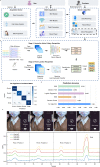Imperceptible, designable, and scalable braided electronic cord
- PMID: 36402785
- PMCID: PMC9675780
- DOI: 10.1038/s41467-022-34918-x
Imperceptible, designable, and scalable braided electronic cord
Abstract
Flexible sensors, friendly interfaces, and intelligent recognition are important in the research of novel human-computer interaction and the development of smart devices. However, major challenges are still encountered in designing user-centered smart devices with natural, convenient, and efficient interfaces. Inspired by the characteristics of textile-based flexible electronic sensors, in this article, we report a braided electronic cord with a low-cost, and automated fabrication to realize imperceptible, designable, and scalable user interfaces. The braided electronic cord is in a miniaturized form, which is suitable for being integrated with various occasions in life. To achieve high-precision interaction, a multi-feature fusion algorithm is designed to recognize gestures of different positions, different contact areas, and different movements performed on a single braided electronic cord. The recognized action results are fed back to varieties of interactive terminals, which show the diversity of cord forms and applications. Our braided electronic cord with the features of user friendliness, excellent durability and rich interaction mode will greatly promote the development of human-machine integration in the future.
© 2022. The Author(s).
Conflict of interest statement
The authors declare no competing interests.
Figures




Similar articles
-
Screen-Printed Washable Electronic Textiles as Self-Powered Touch/Gesture Tribo-Sensors for Intelligent Human-Machine Interaction.ACS Nano. 2018 Jun 26;12(6):5190-5196. doi: 10.1021/acsnano.8b02477. Epub 2018 May 22. ACS Nano. 2018. PMID: 29771494
-
Hybrid carbon nanostructured fibers: stepping stone for intelligent textile-based electronics.Nanoscale. 2019 Feb 14;11(7):3046-3101. doi: 10.1039/c8nr07554a. Nanoscale. 2019. PMID: 30720829 Review.
-
Wearable E-Textiles Using a Textile-Centric Design Approach.Acc Chem Res. 2021 Nov 2;54(21):4051-4064. doi: 10.1021/acs.accounts.1c00433. Epub 2021 Oct 19. Acc Chem Res. 2021. PMID: 34665618
-
Recent Advances and Challenges Toward Application of Fibers and Textiles in Integrated Photovoltaic Energy Storage Devices.Nanomicro Lett. 2023 Jan 20;15(1):40. doi: 10.1007/s40820-022-01008-y. Nanomicro Lett. 2023. PMID: 36662335 Free PMC article. Review.
-
Recent Progress of Textile-Based Wearable Electronics: A Comprehensive Review of Materials, Devices, and Applications.Small. 2018 Jan;14(3). doi: 10.1002/smll.201703034. Epub 2017 Dec 4. Small. 2018. PMID: 29205836 Review.
Cited by
-
In-situ forming ultra-mechanically sensitive materials for high-sensitivity stretchable fiber strain sensors.Natl Sci Rev. 2024 Apr 30;11(6):nwae158. doi: 10.1093/nsr/nwae158. eCollection 2024 Jun. Natl Sci Rev. 2024. PMID: 38881574 Free PMC article.
-
Triboelectric micro-flexure-sensitive fiber electronics.Nat Commun. 2024 Mar 15;15(1):2374. doi: 10.1038/s41467-024-46516-0. Nat Commun. 2024. PMID: 38490979 Free PMC article.
-
Integrated Wearable System for Monitoring Skeletal Muscle Force of Lower Extremities.Sensors (Basel). 2024 Jul 22;24(14):4753. doi: 10.3390/s24144753. Sensors (Basel). 2024. PMID: 39066149 Free PMC article.
-
A high stretchability fiber based on a synergistic three-dimensional conductive network for wide-range strain sensing.Nanoscale Adv. 2024 Nov 25;7(2):517-523. doi: 10.1039/d4na00770k. eCollection 2025 Jan 14. Nanoscale Adv. 2024. PMID: 39640005 Free PMC article.
-
Stretchable and Self-Powered Mechanoluminescent Triboelectric Nanogenerator Fibers toward Wearable Amphibious Electro-Optical Sensor Textiles.Adv Sci (Weinh). 2024 Sep;11(34):e2401109. doi: 10.1002/advs.202401109. Epub 2024 Jul 5. Adv Sci (Weinh). 2024. PMID: 38970168 Free PMC article.
References
MeSH terms
LinkOut - more resources
Full Text Sources

